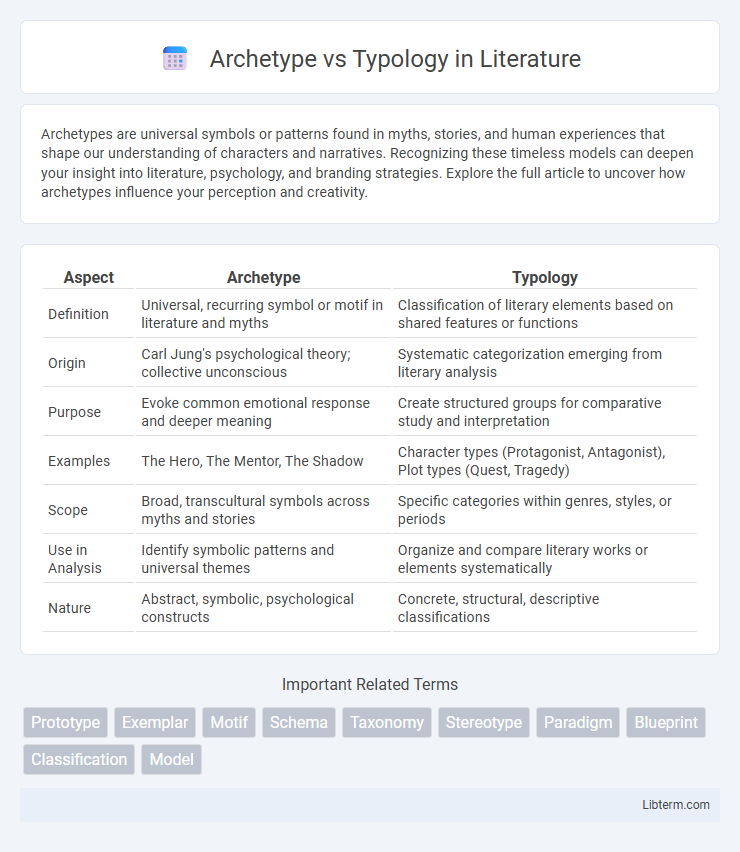Archetypes are universal symbols or patterns found in myths, stories, and human experiences that shape our understanding of characters and narratives. Recognizing these timeless models can deepen your insight into literature, psychology, and branding strategies. Explore the full article to uncover how archetypes influence your perception and creativity.
Table of Comparison
| Aspect | Archetype | Typology |
|---|---|---|
| Definition | Universal, recurring symbol or motif in literature and myths | Classification of literary elements based on shared features or functions |
| Origin | Carl Jung's psychological theory; collective unconscious | Systematic categorization emerging from literary analysis |
| Purpose | Evoke common emotional response and deeper meaning | Create structured groups for comparative study and interpretation |
| Examples | The Hero, The Mentor, The Shadow | Character types (Protagonist, Antagonist), Plot types (Quest, Tragedy) |
| Scope | Broad, transcultural symbols across myths and stories | Specific categories within genres, styles, or periods |
| Use in Analysis | Identify symbolic patterns and universal themes | Organize and compare literary works or elements systematically |
| Nature | Abstract, symbolic, psychological constructs | Concrete, structural, descriptive classifications |
Understanding Archetype and Typology: Core Definitions
Archetypes are universal, primordial symbols or patterns embedded in the collective unconscious, representing fundamental human motifs across cultures and time. Typology classifies entities into categories based on shared characteristics, emphasizing differences within a structured system for understanding variations. Understanding archetypes involves recognizing their role in shaping narratives and behaviors, while typology focuses on organizing phenomena into distinct types for clearer analysis.
Historical Origins of Archetypes and Typologies
Archetypes originated from Carl Jung's analytical psychology, representing universal, primordial symbols embedded in the collective unconscious throughout human history. Typologies, on the other hand, emerged from early philosophical and anthropological studies aimed at classifying human behavior and personality into specific categories. Historical examination reveals archetypes as deep-rooted psychological patterns, whereas typologies function as systematic frameworks for analyzing observable traits and social roles.
Key Differences Between Archetype and Typology
Archetypes represent universal, symbolic patterns inherent in human psychology and culture, while typology categorizes entities based on specific traits or characteristics within a defined system. Archetypes function as fundamental, timeless models often employed in literature and mythology to convey shared human experiences, whereas typologies provide systematic classifications, such as personality types in psychology (e.g., Myers-Briggs Type Indicator). The key difference lies in archetypes embodying abstract, collective symbols transcending individual differences, whereas typologies emphasize empirical categorization based on observable or measurable attributes.
Common Examples of Archetypes
Common examples of archetypes include the Hero, the Mentor, and the Shadow, which serve as universal symbols in literature and psychology. The Hero archetype embodies courage and perseverance, while the Mentor offers wisdom and guidance. Unlike typologies, which categorize personality traits or behaviors into fixed types, archetypes represent recurring motifs or roles that resonate across cultures and time periods.
Popular Typology Systems in Psychology and Literature
Popular typology systems in psychology, such as the Myers-Briggs Type Indicator (MBTI), categorize individuals based on personality traits like Introversion, Extraversion, Thinking, and Feeling, providing a practical framework for understanding human behavior. In literature, typology often refers to recurrent character types or motifs that symbolize broader archetypal themes, like the Hero or the Trickster, which are universally recognized across cultures. Archetypes, originating from Carl Jung's theories, represent innate, universal prototypes of human experience, while typologies offer structured classifications that describe specific variations within those archetypal patterns.
Functions of Archetype in Storytelling and Culture
Archetypes in storytelling serve as universal symbols and character models that evoke deep emotional responses and convey fundamental human experiences across cultures. These narrative functions enable storytellers to create relatable characters and plot structures that resonate on a subconscious level, facilitating cultural transmission and collective meaning-making. In contrast, typology categorizes these elements systematically but lacks the dynamic functional role archetypes play in influencing individual and societal identity within myths and literature.
Applications of Typology in Personality and Classification
Typology in personality psychology classifies individuals into distinct categories based on traits, enabling targeted approaches in therapy and personal development. It aids in organizing complex human behaviors into manageable groups, facilitating tailored interventions and predictive outcomes. In broader classification, typology enhances data structuring by categorizing objects or concepts into defined types, improving analysis and decision-making processes.
Overlaps and Intersections: Where Archetypes Meet Typologies
Archetypes and typologies intersect in their shared goal of categorizing human behavior and personality traits, often revealing common patterns such as the Hero archetype aligning with extroverted leadership typologies. Both frameworks utilize symbolic representations to organize complex psychological or social data, enhancing understanding of individual differences and group dynamics. Their overlap is evident in fields like psychology and marketing, where blending archetypal narratives with typological profiles creates deeper insights into consumer motivations and identity formation.
Limitations and Critiques of Archetype and Typology
Archetypes often face criticism for their overly simplistic and generalized nature, which can lead to stereotypical interpretations and a lack of cultural specificity. Typology is limited by its rigid categorization, risking the oversimplification of complex individual or group behaviors and potentially ignoring context and variability. Both frameworks struggle with empirical validation, as their abstract concepts are difficult to quantify or test scientifically.
Choosing Between Archetype and Typology for Analysis
Choosing between archetype and typology for analysis depends on the depth and specificity of the research focus. Archetypes offer broad, universal patterns that capture fundamental human experiences, ideal for exploring symbolic and psychological themes. Typologies provide a more structured classification based on distinct criteria, making them suitable for detailed comparison and categorization within specific contexts.
Archetype Infographic

 libterm.com
libterm.com